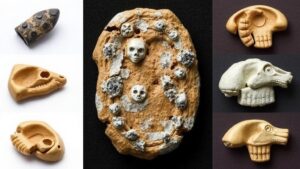Ancient Desert Tracks: Fossilized Footprints from Long-Lost Wildlife
Ancient Desert Tracks: Fossilized Footprints from Long-Lost Wildlife
For rockhounds and mineral collectors, the allure of uncovering ancient footprints serves as both an exciting pursuit and an educational journey into the past. Fossilized footprints offer a rare glimpse into the behavior, environment, and evolution of prehistoric life, making them invaluable to both collectors and paleontologists. This article delves into the significance of these fossilized tracks, their locations, and practical tips for aspiring collectors.
The Significance of Fossilized Footprints
Fossilized footprints, also known as trace fossils, are crucial for studying past life on Earth. Unlike body fossils, which include bones or shells, trace fossils document the activity of organisms. These footprints can reveal a wealth of information such as:
- The species of the animal that left the track
- Behavioral patterns, such as hunting or migration
- Environmental conditions, including terrain and climate
For example, the discovery of dinosaur footprints in the Morrison Formation of Colorado has helped paleontologists determine that these creatures traveled in herds and their size could be inferred from the depth and width of their tracks.
Where to Find Fossilized Footprints
Fossilized footprints can be found in various regions known for their sedimentary rock formations. Some notable locations include:
- The La Brea Tar Pits (California): Famous for its Ice Age fossils, this site has provided numerous tracks from prehistoric animals, including saber-toothed cats and giant ground sloths.
- The Dinosaur Valley State Park (Texas): This park contains some of the most well-preserved dinosaur tracks, allowing collectors to view actual prints embedded in the riverbed.
- Laigle Quarry (France): Renowned for its exceptional dinosaur footprints, this location features some of the largest trackways, measuring over 3 feet in length.
Identifying Fossilized Footprints
Identifying fossilized footprints involves understanding both the anatomy of the species and the geological context. Factors to consider include:
- Size and Shape: The dimensions of the footprint can indicate the species. For example, large, three-toed tracks generally belong to theropod dinosaurs.
- Depth: Deeper tracks suggest heavier animals, while shallower prints could indicate smaller creatures.
- Track Width: Wider tracks might signify a species that walked on softer surfaces or had a particular gait.
Practical Tips for Collectors
Collecting fossilized footprints requires patience and respect for regulations. Here are some essential tips:
- Research Local Laws: Ensure that you are permitted to collect fossils in the area. Federal and state lands often have strict regulations regarding fossil collection.
- Use Proper Tools: A small trowel, brushes, and a camera can help document your findings without damaging the fossils.
- Join Local Rockhound Clubs: Connecting with other enthusiasts can provide valuable insights and opportunities for field trips.
The Future of Fossilized Footprint Research
Recent advancements in technology, such as 3D scanning and imaging techniques, are revolutionizing the study of fossil footprints. These methods allow for enhanced analysis and preservation, enabling scientists to create detailed models that can be studied without damaging the original fossils. This digital approach not only aids in academic research but also enhances the visitor experience in museums.
Conclusion
Fossilized footprints are more than just remnants of the past; they are time capsules that provide invaluable insights into ancient wildlife and ecosystems. For rockhounds and mineral collectors, engaging with these prehistoric tracks offers a unique blend of adventure and education. By understanding their significance, knowing where to find them, and using the right techniques to identify and preserve them, collectors can enjoy the thrill of discovery while contributing to the field of paleontology.
Incorporating these practices into your collecting journey can lead to fruitful adventures, enriching your understanding of the Earths history and the diverse life forms that have walked its surface.



